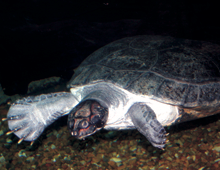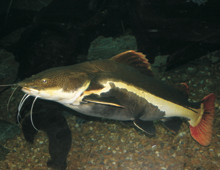Orinoco

Arrau turtle, Podocnemis expansa
This South American turtle is famous for the mass gatherings of females that come ashore to lay their eggs, often a hundred at a time. Otherwise, these plant-eaters hardly ever leave the water. Females are much larger than males, reaching a shell length of three feet. Because their eggs and flesh have long been prized as food, they have been subject to overhunting, and are now classified as Conservation Dependent.
LEARN MORE
Spotted shovel-nose catfish, Pseudoplatystoma corruscans
The various shovel-nosed catfishes of South America are popular inhabitants of large aquariums and important food fishes in their native rivers. As their huge mouths would suggest, they are active predators, hunting for others fishes and crustaceans at night. They easily grow to over three feet.
LEARN MORE
Fork-snouted catfish, Oxydoras niger
No relation to sturgeons, this huge relative of the little “talking catfishes” (popular with aquarists) possesses similar looking bony scutes along its side, giving it a prehistoric appearance. One of its other aquarium shop names is in fact “Prehistoric catfish” and another is “Ripsaw”. Though exceeding three feet in length, they feed almost entirely on invertebrates and detritus, as one might deduce from their small mouths.
LEARN MORE
Red-tailed catfish, Phractocephalus hemioliopterus
All of the many Red-tailed catfish at the DWA are donations from aquarists whose tanks they rapidly outgrew. Popular in the pet trade since the 1960s, this widespread South American fish is often sold at a length of two inches, but may eventually reach five feet and weigh over 100 pounds, potentially eating anything it can swallow.
LEARN MORE
Arapaima, Arapaima gigas
Called Arapaima in the Guianas, Paiche in Peru, and Pirarucu in Brazil, this relative of the arowana is one of the largest purely freshwater fishes in the world, reaching nine feet and exceeding 400 pounds. They have been overexploited as food fishes, so are vulnerable to extinction. These fast-growing predators surface frequently to take air at the surface. While aquarium visitors may mistake them for Alligator gars, they are not related. Their closest North American relatives are the herring-like Mooneyes and Goldeneyes.
LEARN MORE
Antillean manatee, Trichechus manatee
Distant relatives of elephants and hyraxes, West Indian manatees occur in two subspecies. The Antillean manatee of Central and South America, and various Caribbean islands, is almost identical to the Florida manatee (T. manatus laterostris), being slightly smaller with a narrower skull.
LEARN MORE
Giant otter, Pteronura brasiliensis
While Sea otters can also weigh up to 100 pounds, Giant otters are definitely the longest members of the weasel family, reaching five-and-a-half feet in length. Found in noisy groups of up to eight, related animals along rivers in tropical South America, they are active only during the day time. Although they have the shortest fur of any otter, their hides have been traditionally valued, and the fur trade has led to their being listed as an endangered species. Until recently, it was a very rare animal in zoos, but increasing numbers are being bred in captivity.
LEARN MORE
Giant anteater, Myrmecophaga tridactyla
This enormous relative of sloths and armadillos is found all the way from Honduras to Argentina, but has gone extinct in several parts of this range, and is considered vulnerable to extinction everywhere. More than 250 are maintained in more than 100 zoos around the world, where they breed frequently. True to its name, it rips apart the nests of ants and termites with its powerful claws, then gathers them into its toothless jaws with its long, muscular tongue. In zoos it is fed protein-rich diets prepared in blenders.
LEARN MORE
Caiman Lizard, Dracaena guianesis
In North America, the Teiid family of lizards is represented by rather small racerunners and whiptails, which have the appearance of “typical lizards”. In South America, Teiids occur in much greater variety. One of the most specialized is the semi-aquatic Caiman lizard, named for its crocodilian-like scales. Growing up to four feet long, often with a bright orange head contrasting with a greenish body, it might present a ferocious appearance. Its diet, however, consists almost entirely of snails, which it crushes with enormous molar-like teeth.
LEARN MORE

